Sony A1 II evaluate – a refined flagship
Sony A1 II: two-minute evaluate
Mix a splash of the Sony Alpha A1, a splash of the Sony A9 III, a sprinkling of all-new refinements, give it a stir, and voilà… you have got the Sony A1 II, Sony’s best-ever Alpha digicam, and among the best hybrid skilled cameras out there.
It is not fairly as fast because the A9 III with its international shutter, limitless flash sync velocity and 120fps burst taking pictures, nor does it fairly produce the identical highly-detailed photos because the 61MP A7R V; however the A1 II is the very best Sony has to supply for element and velocity in a single digicam.
That sprint of the A1 is identical full-frame back-illuminated 50MP stacked sensor, powered by Sony’s Bionz XR processor for 30fps burst taking pictures and 8K video as much as 30fps with 10-bit 4:2:2 coloration depth, plus 4K 120fps slow-motion video.
The sprinkling of the A9 III (that upgrades this digicam over the A1) is a like-for-like design, which means a bigger handgrip with a nicely-angled shutter button, a bigger 3.2-inch multi-angle touchscreen with higher coloration depth, more practical picture stabilization now rated as much as 8.5EV, Sony’s AI processing chip, plus an extra customized button for the likes of an immediate increase in velocity for burst taking pictures.

Lastly, the sprinkling of the all-new features a new ‘Auto’ subject-detection autofocus mode, which means you do not have to manually choose the topic kind forward of time, although you continue to can in the event you’d slightly. Customers may import customized LUT coloration profiles, along with Sony’s common S-Log3 and S-Cinetone coloration profiles which might be built-in.
The message right here is that there is virtually nothing new within the A1 II, which is very uncommon for a Sony flagship digicam, particularly after such a quiet 2024 for the digicam big, with this being the primary new full-frame Alpha this yr.
The A1 II combines glorious A1 and A9 III attributes in a single digicam, however there’s little right here to get enthusiastic about. Sony has barely decreased the launch worth in comparison with the A1 when it was introduced virtually fours in the past, in order that’s one thing not less than. Nevertheless, Sony’s hand has been considerably pressured by cheaper rivals coming onto the scene because the A1 – the Nikon Z8 and Canon EOS R5 Mark II, and in comparison with them it feels overvalued. As an example, on the time of writing you may get two Z8’s on sale for a similar worth as one A1 II.
In the end, Sony has created a elegant improve over the first-gen mannequin that is prone to please professionals who depend on their gear each day in difficult conditions. It might not be an thrilling improve, however the Sony A1 II is up there with the perfect cameras we have examined.
Sony A1 II: worth and launch date
- Physique-only worth is $6,500 / £6,300 / AU$10,989
- Out there since late November
- New BC-ZD1 charger and VG-C5 grip (bought individually)
The Sony A1 II went on sale from late November 2024 with a listing worth of $6,500 / £6,300 / AU$10,989. That is a fraction decrease than the launch worth of the A1 from all the way in which again in 2021. In a single sense that is commendable on Sony’s half, however then again the market has modified, and the A1 collection has now has completed rivals that provide maybe 90% of the all-round bundle however value a lot much less. Sony wanted to be aggressive with its pricing, and it has been to an extent, however the Nikon Z9 particularly seems very cheap by comparability and the Nikon Z8 and Canon EOS R5 Mark II are cheaper nonetheless.
Sony A1 II: specs
| Sensor: | Full-frame, 50MP stacked CMOS |
| Video: | 8K 30p / 4K 120p |
| Cont. taking pictures | 30fps for as much as 153 uncooked pictures |
| Viewfinder: | 9.44m-dot EVF |
| LCD: | 3.2-inch mulit-angle touchscreen 2.1m-dots |
| Battery: | 520 pictures |
| Weight: | 24.7oz / 700g (with battery and card) |
| Dimensions: | 136.1 x 96.9 x 82.9mm |
Sony A1 II: design and dealing with
- Similar design because the A9 III
- Sensible management format with useful shortcuts to incessantly used options
- New devoted mic for voice memos
When it comes to change from the A1, you get a bigger 3.2-inch multi-angle touchscreen, with the twin hinge enabling customers to tilt and angle the display for straightforward viewing at excessive or low angles whether or not they’re taking pictures vertical or horizontal. That dual-hinge design additionally lets you pull the display additional away from the physique and its chunky viewfinder eye-piece, which might in any other case partially impede the display (the A1 II comes with two eye-pieces, one in all which has a bigger cup).
Whereas we’re on the viewfinder, it’s once more a 9.44m-dot OLED show which is but to be bettered, nonetheless this time the refresh fee is doubled from 60fps to 120fps for a smoother expertise, or an excellent smoother maxi um 240fps refresh fee, albeit the decision of the show drops.
The A1 II’s handgrip is extra rounded and all-round chunkier, and I really feel prefer it slots into the hand higher than the grip on the A1, although they’re related in depth. There are little refinements too, such because the shutter button being angled barely otherwise and simpler to press.
As on the A9 III, there’s an extra customized button on the entrance of the A1 II, which is factory-set to behave as a velocity increase for steady burst taking pictures. The thought is that you do not at all times wish to be taking pictures on the most body fee, which on this case is 30fps, however you may instantly want that velocity, and the button means that you can tick over at a decrease body fee and get an immediate injection of additional frames whenever you want it.
One function that caught my eye within the authentic A1, and has once more right here, is the max flash sync velocity of 1/400 sec. That beats the Nikon Z9 for instance, making the A1 II a extra versatile digicam for flash images, particularly in the event you like utilizing a large aperture. Nevertheless, Sony’s personal A9 III is extra versatile nonetheless, with what’s successfully has a vast flash sync velocity.
The A1 II can be a particularly rugged weatherproof digicam, with properly designed inflexible doorways on the connection ports that keep out of the way in which when the ports are in use, whereas the twin reminiscence card door encompasses a push lock and is a greater design than Nikon’s, which might simply be knocked open.
Try our A9 III evaluate to be taught extra in regards to the A1 II’s design – the 2 cameras share virtually the identical design.
Sony A1 II : options and efficiency
- Improved picture stabilization, as much as 8.5EV
- Similar 759-point AF array, now with AI processing unit for topic detection
- 30fps burst taking pictures for as much as 153 uncooked pictures, now with pre-capture
Sony has delivered one notable {hardware} enchancment over the A1, including an AI processing unit that was debuted within the A7R V. This could ship higher subject-detection autofocus for picture and video in comparison with the A1, although we’ve not examined the A1 II in opposition to the A1, each of which share the identical 759 AF level array, to see simply how a lot of a distinction it makes.
Having used Sony’s earlier skilled Alphas, I used to be most eager to check out the brand new Auto subject-detection autofocus mode. Annoyed by what really feel to me like unnecessarily complicated topic detection decisions that it is advisable to manually choose forward of time – people, birds, animals, automotive, bugs, planes, trains and so forth, I’ve known as on manufacturers so as to add an auto mode that simplifies the expertise. Cue the A1 II and its new mode.
In comparison with the devoted topic detections modes which might be nonetheless out there, there’s little or no to decide on between the efficiency of the brand new Auto mode. The Auto possibility carried out equally effectively for me when taking pictures portraits of individuals, locking reliably onto my topic’s eyes, and through a soccer sport capturing the fast-paced professional gamers in motion. That mentioned, I have never conjured up a state of affairs particularly for the sake of testing potential weaknesses the Auto mode might need.
Sony additionally says the next-gen autofocus is ready to acknowledge the top and physique of people / animals, and that its efficiency is 30% more practical than the A1’s for detecting human and animal eyes, whereas the digicam’s autofocus can function successfully in low gentle right down to -4EV. Till not too long ago in the event you’d requested me the very best autofocus system out there I would say Sony with out hesitation, however Canon’s newest efforts within the EOS R1 and EOS R5 Mark II are mightily spectacular too, particularly the brand new sports activities precedence modes. I could not let you know which is best now with out operating a direct comparability.

One other similarity between this digicam and its predecessor is that each can shoot at a burst fee of as much as 30fps for the same size of time earlier than slowing down – a bit over 150 uncooked frames or near 180 JPEGs. For such events, that speed-boost button is infinitely useful for bettering effectivity and workflow by enabling you to adapt your taking pictures fee.
The A1 II additionally will get a useful pre-capture function. Pre-capture is nothing new, though Sony was late to the occasion, solely introducing it to an Alpha digicam with the A9 III. Put merely, pre-capture can buffer as much as one second’s value of images – on this case 30 images – earlier than you totally press the shutter button to begin capturing a high-speed sequence. That one second of grace whenever you’re sluggish to react could possibly be the distinction between capturing the second and lacking it fully.
- Options and efficiency rating: 4.5/5
Sony A1 II: picture and video high quality
- 50MP stills and 8K/30p video
- 4:2:2 10-bit coloration depth and Sony’s S-Log3, S-Cinetone, plus LUT imports
- Pixel Shift and Noise Discount taking pictures modes
Sony’s 50MP full-frame stacked sensor is a confirmed performer, delivering sharp stills with as much as 15EV of dynamic vary. The A7R V’s 61MP sensor will get you marginally higher element, however the A1 II is a a lot quicker performer. Moreover, in-body picture stabilization is improved over the A1, and you may typically get barely sharper finish outcomes when taking pictures handheld, relying on the digicam’s shutter velocity and the way regular your hand is.
Versus the 24MP Sony A9 III for sports activities, I actually appreciated the upper decision 50MP sensor which provides you additional scope for cropping into pictures, and which allows a 21MP APS-C mode – with which you successfully lengthen the focal size of your lens by 1.5x. The soccer images beneath have been taken from appreciable distance with a 400mm lens, however I might crop in and body precisely how a 600mm lens may look.
As soon as once more Sony’s Pixel Shift Multi Capturing mode options, combining as much as 16 pictures for one bigger 199MP composite picture. It is not as efficient as Canon’s new in-camera AI upscaling function within the EOS R1 / EOS R5 Mark II, particularly if there’s any motion in your shot. Nevertheless, in conditions resembling nonetheless lifes within the studio it will increase element by as much as 400%. Sony has additionally added a brand new Noise Discount taking pictures mode that, like Pixel Shift, combines a number of pictures however on this case for a cleaner picture, particularly in low gentle.
Outright picture high quality is, in impact, the identical as from the A1, which is an efficient factor, with clear pictures as much as ISO 12,800 from the A1 II’s ISO 100-32,000 vary. The just about four-year-old sensor has stood the take a look at of time. The place we actually see enhancements in picture high quality is within the optimistic impact of improved picture stabilization for handheld pictures and much more dependable subject-detection autofocus for taking pictures animals, automobiles, individuals, and so forth.
As for video high quality, once more it is principally as you have been from 2021’s A1: 8K as much as 30fps, 4K 60fps in 4:2:2 10-bit from the full-width of the sensor, or 4K as much as 120fps with a slight crop. Fortunately, the A1 was forward of its time and the A1 II nonetheless holds up at present, plus it throws in some new options resembling 1/48sec and 1/96sec body charges for true 180-degree shutter angle at common cinematic body charges. It additionally brings LUT imports (with help for monitor LUT show), plus AI-based Auto Framing à la ZV-E1.
- Picture and video high quality rating: 4.5/5
Sony A1 II: testing scorecard
| Attributes | Notes | Ranking |
|---|---|---|
| Value | Cheaper than predecessor, however new rivals are a lot less expensive. | 3/5 |
| Design | Sony’s best-ever mirrorless digicam design, borrowed from the A9 III. | 5/5 |
| Efficiency | Velocity and high quality, with improved autofocus and picture stabilization. | 4.5/5 |
| Picture and video high quality | Reveals simply how forward of the occasions the Sony A1 was – with a lot the identical high quality three years later the A1 II nonetheless holds its personal. | 4.5/5 |
Ought to I purchase the Sony A1 II?
Purchase it if…
Do not buy it if…
Sony A1 II: additionally think about
The Nikon Z9 ought to be the A1 II’s rival, however the smaller and cheaper-still Z8 has an identical type issue to the A1 II and loads of related options, not less than on paper. The 2 full-frame mirrorless cameras shoot high-resolution stills at 45MP (Z8) to 50MP (A1 II), 8K video, and each deal with very well. Every digicam has minor benefits over the opposite, however essentially the most hanging distinction of all is worth – you’ll be able to choose up two Nikon Z8s for the worth of 1 Sony A1 II.
Learn our in-depth Nikon Z8 evaluate
For velocity and high quality, Canon affords the EOS R5 Mark II, TechRadar’s Digicam of the yr 2024 winner. It was a big improve of the EOS R5, including severe energy below the hood to the 45MP stills and 8K video expertise. A newly-designed stacked sensor and second processor improved velocity, whereas new autofocus expertise – together with sports activities precedence modes – are a match if not higher than Sony. Canon’s all-in-one full-framer is less expensive than the A1 II too, though Nikon’s Z8 is cheaper nonetheless. General, the brand new Canon mannequin could possibly be essentially the most compelling of the three. Professionals are spoilt for selection!
Learn our in-depth Canon EOS R5 Mark II evaluate
How I examined the Sony A1 II

- I examined a full-production mannequin with ultimate firmware, over two single week durations
- Used with a number of lenses, together with the FE 28-70mm F2 GM lens and 400mm F2.8 GM OSS
- I used it with Sony’s Creator Cloud app
I examined a ultimate firmware model of the Sony A1 II forward of launch, along with the brand new Sony FE 28-70mm F2 GM lens, for per week. I consequently used it after launch for sports activities images. The A1 II’s uncooked recordsdata weren’t readable in modifying software program on the time of testing.
I have been taking pictures with a CFexpress Kind A card to get the very best efficiency from the digicam, and recorded burst sequences at TechRadar’s normal digicam testing settings: 1/250 sec, ISO 200, and steady AF.
Sony’s Creator Cloud app works with the A1 II, and I used the app to remotely shoot pictures with the digicam and add pictures too. I shot portraits of people and animals with the varied subject-detection autofocus modes.
I’ve additionally examined the A1 II for professional sports activities, and in a spread of climate circumstances and varied occasions of day / evening.
First reviewed November 2024





